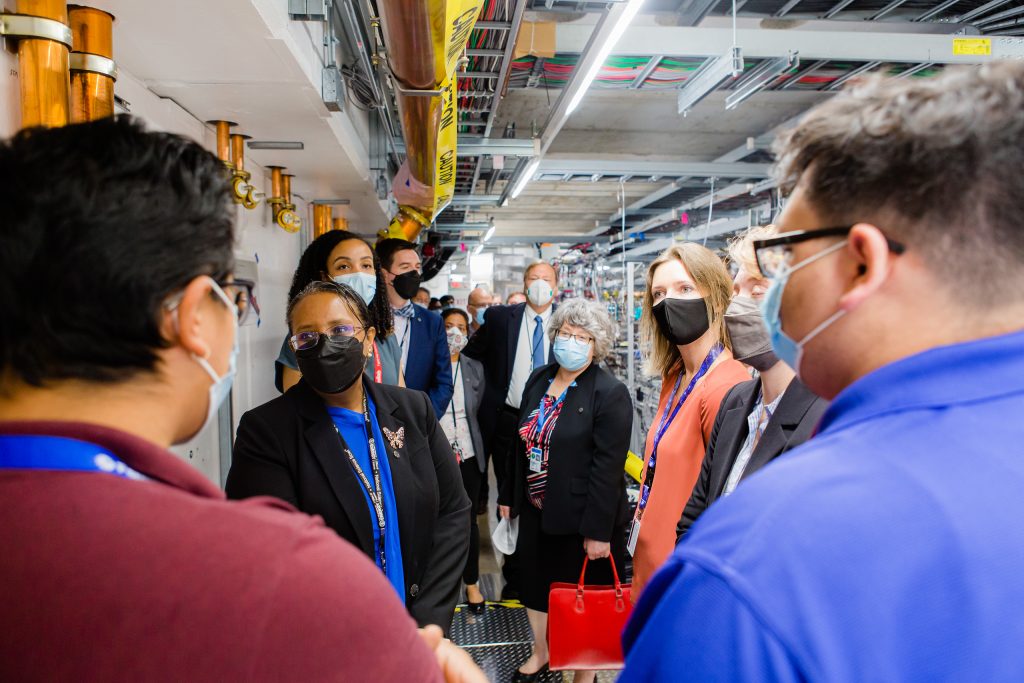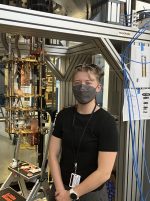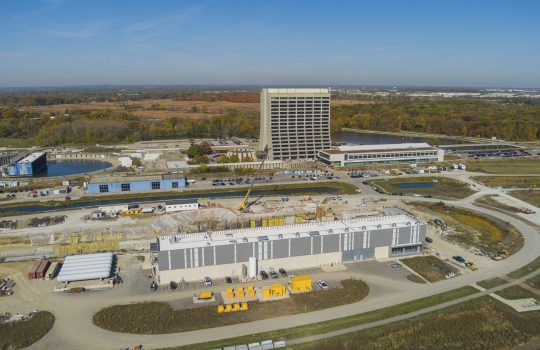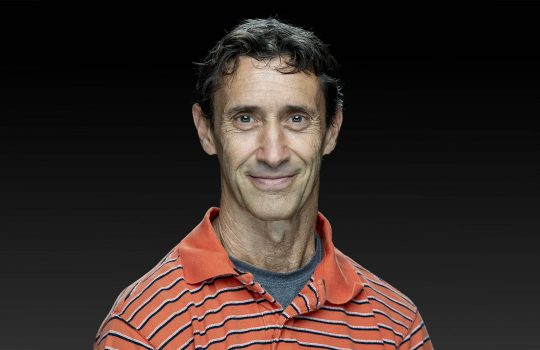This year, six engineering students spent their summers at the U.S. Department of Energy’s Fermi National Accelerator Laboratory, working alongside world-class engineers and scientists as part of the accelerator upgrade project known as Proton Improvement Plan II, or PIP-II. The students now are back at school for the academic year, but they are still contributing to the design, development and construction of one of the most powerful particle accelerators in the world.
These students are part of the inaugural cohort of the Fermilab ASPIRE Fellowship: Accelerator Science Program to Increase Representation in Engineering. ASPIRE provides immersive learning experiences to undergraduate and graduate engineering students from backgrounds that are historically and contemporarily underrepresented in accelerator engineering fields, including Black, Latinx, Indigenous identities and women.

ASPIRE fellows (in the foreground and on the right) meet with DOE Director Asmeret Berhe (blue shirt, black mask) and Fermilab Director Lia Merminga (red bag) in July 2022. Photo: Tom Nicol
Under the guidance of an experienced, deeply knowledgeable mentor, ASPIRE fellows are immersed in leading-edge research and development during the 15- to 18-month fellowship. Students realize professional growth through the acquisition of in-demand engineering skills and the establishment of professional networks within the U.S. accelerator science and technology community.
Learn about five of this year’s ASPIRE fellows and their projects:
Sana Begum is a second-year graduate student at Northern Illinois University; she’s working with Brian Chase, an electrical and radio frequency engineer, on the beam pattern generator.
One of the key features of the new linear accelerator enabled by PIP-II will be its ability to deliver defined beam bunch patterns on target, thereby enabling customization of beam delivery to experiments. The beam pattern generator is the system that determines the bunch pattern, among other things.
“My favorite part was when I was meeting the team, getting to know them and being passionate to learn new things,” said Begum. She also said, despite her stage fright, “I was able to give the final presentation [of the summer session] in front of an intelligent audience. That was a huge success!”
Mark Anthony Castellanos, a master’s student at Binghamton University, works with Cristian Boffo, a mechanical and superconductivity engineer, to create an interface for a new magnet test stand being used to experimentally test the magnets for PIP-II. Castellanos made the interface in Labview, an instrumentation control and monitoring software. The program displayed measurements, such as temperature, pressure, magnetic field generated, voltage and current.
“My favorite part of the ASPIRE program has been applying what I learned in class to a meaningful project,” said Castellanos. “In school, most coding programs solve math problems or control small robots. This opportunity allowed me to program something bigger and potentially work on the experimental testing as well.”
Castellanos’s advice to next year’s fellows: “In the beginning the project might seem large and overwhelming. Breaking it down into smaller goals and doing your research can help get the project moving along.”
Parker Landon is a first-year doctoral student at Boston University, working with Aisha Ibrahim, an electrical and instrumentation engineer, on instrumentation. This summer, Landon helped to develop an inter-integrated-circuit bus that handled communication to and from the instrumentation infrastructure and is now working on system characterization for the wall current monitor for PIP-II.
“I really enjoyed being able to apply my knowledge from undergrad in a true engineering environment,” she said. “You get to work with professionals from all fields and see how projects develop real-time. It was also pretty fun to work inside the accelerator!”
Landon’s advice to future interns is, “Explore and visit everywhere! Check out all the different departments, meet new people and ask questions. Although I was in Instrumentation with the Accelerator Division, I was able to watch a group in SiDet build a quantum sensor!”
Victor Aguado Rodriguez is a graduate student at Northern Illinois University, working with Curtis Baffes, a mechanical engineer, on the development of an access platform for the cryogenic distribution system, or CDS. This platform will be situated above the CDS, adjacent to the cryomodules, allowing workers to move through the PIP-II tunnel and have easier access to components on the CDS and cryomodules.
Rodriguez’s favorite part of ASPIRE so far is, “learning about all the different work being done at Fermilab from people you can tell are passionate about their work.”
Rodriguez said to future ASPIRE fellows, “I recommend getting to know everybody around you, especially the other interns.”
Monika Sadowski, a senior undergraduate student at Northern Illinois University, is working with Maurice Ball, a mechanical fluid systems engineer, on a few different projects, including updating AutoCad drawings of various components, revising specifications documents and creating engineering notes.
Her favorite part of the fellowship is “meeting all the great people who work at Fermilab and being part of the PIP-II project.”
Sadowski’s advice to future ASPIRE fellows: “Get ready to learn something awesome and receive a lot of new information.”
Does the fellowship sound like a fit for you or a student you know? Applications for the 2023 ASPIRE Fellowship are now open. Learn more about it, including eligibility requirements and compensation, then apply by Jan. 31, 2023. Learn more about it, including eligibility requirements and compensation, then apply by Jan. 31, 2023.
Fermi National Accelerator Laboratory is supported by the Office of Science of the U.S. Department of Energy. The Office of Science is the single largest supporter of basic research in the physical sciences in the United States and is working to address some of the most pressing challenges of our time. For more information, please visit science.energy.gov.








